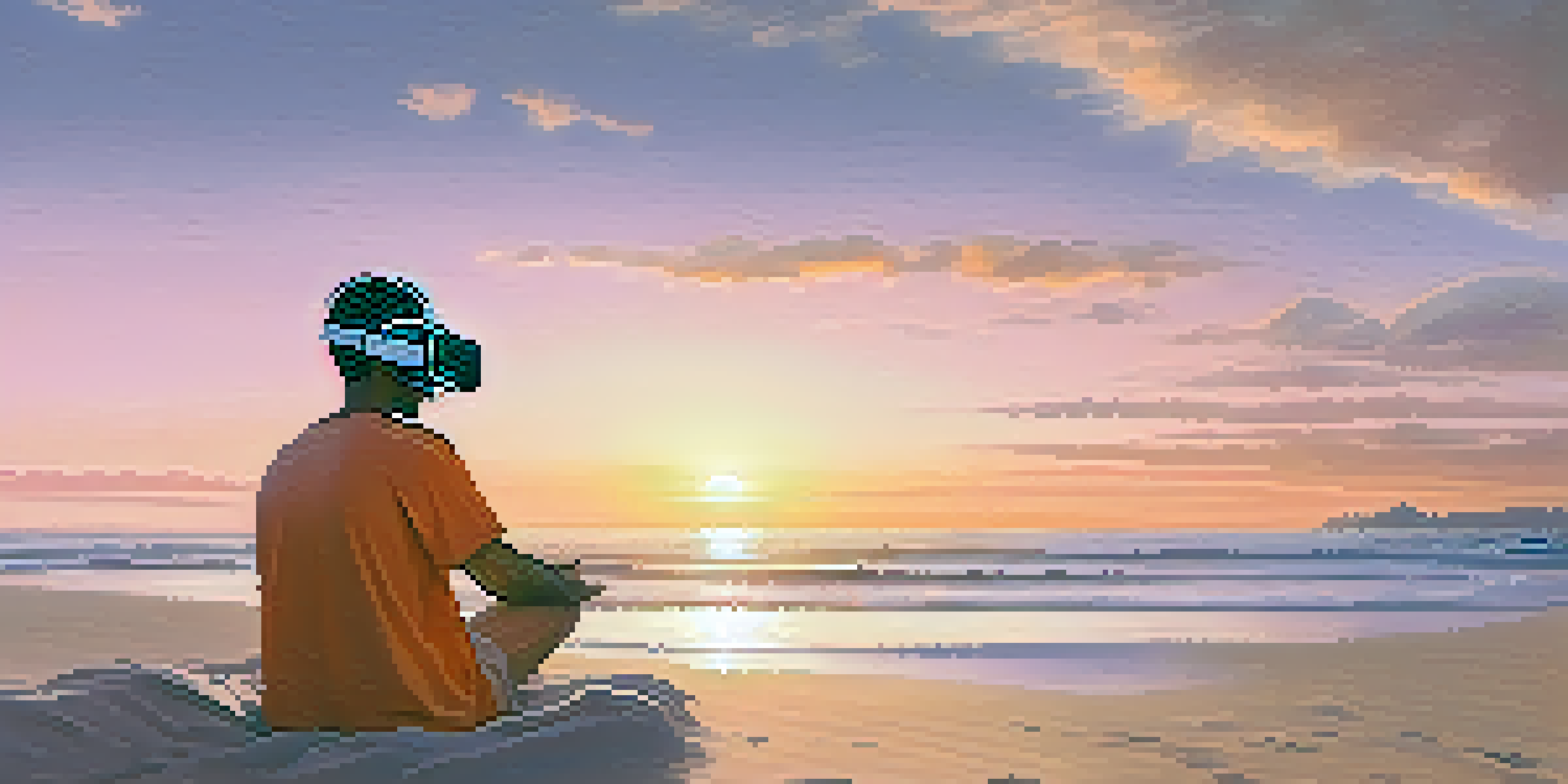Integrating VR into Hallucinogen-Assisted Therapy Sessions

Understanding Hallucinogen-Assisted Therapy
Hallucinogen-assisted therapy involves using substances like psilocybin or LSD to help patients process emotional trauma and mental health challenges. These substances can foster profound experiences that lead to insights and healing when guided by a trained therapist. However, the experience can be unpredictable, which is where virtual reality (VR) comes into play.
The mind is everything. What you think you become.
VR can provide a controlled, immersive environment that enhances the therapeutic experience. By simulating calming landscapes or engaging scenarios, it can help patients feel more comfortable and safe during their sessions. Think of it as creating a supportive backdrop for their inner journey, allowing them to focus on their thoughts and feelings without external distractions.
Integrating VR into this therapy not only helps in managing anxiety but also enriches the emotional experience. By providing visual and auditory stimuli that resonate with the patient’s mental state, VR can facilitate deeper emotional processing. This combination of hallucinogens and VR aims to create a more profound therapeutic effect, potentially leading to lasting change.
The Role of VR in Enhancing the Experience
Virtual reality creates a unique space for individuals to explore their consciousness. Imagine stepping into a world where your fears and emotions manifest visually, allowing you to confront them in a safe manner. This immersive aspect can help patients better articulate their feelings and experiences during therapy.

Moreover, VR can be tailored to individual needs, providing personalized experiences that align with each patient's therapeutic goals. For example, someone dealing with anxiety might benefit from a serene beach scene, while another person might find healing in a vibrant forest. This customization can enhance engagement and lead to more meaningful insights.
VR Enhances Therapeutic Experience
Integrating virtual reality into hallucinogen-assisted therapy creates a controlled, immersive environment that helps patients process emotions and insights more effectively.
By integrating VR, therapists can guide patients through their sessions more effectively. With VR tools, therapists can create scenarios that evoke specific memories or emotions, facilitating deeper exploration. This structured approach allows for a more comprehensive understanding of the patient’s psyche, making therapy sessions feel more purposeful.
Potential Benefits of VR in Therapy
The benefits of incorporating VR into hallucinogen-assisted therapy are numerous. One significant advantage is the potential for increased patient comfort. Being in a familiar or soothing virtual environment can alleviate anxiety and enhance the therapeutic experience, making it easier for individuals to open up.
The greatest discovery of my generation is that a human being can alter his life by altering his attitudes.
Another benefit lies in the ability to revisit experiences safely. Patients can use VR to recreate specific scenarios or memories without the overwhelming emotional weight that may come with them in real life. This controlled exposure allows for gradual processing, which can lead to breakthroughs in understanding and healing.
Additionally, VR can help bridge the gap between sessions. Patients can use VR tools at home to reinforce techniques learned during therapy. This continuity can enhance the overall effectiveness of the treatment, promoting healthier coping mechanisms and emotional resilience.
Challenges in Integrating VR and Therapy
While the integration of VR into hallucinogen-assisted therapy is promising, it does come with its challenges. One major hurdle is the technological barrier; not all therapists may have access to the latest VR equipment or the training needed to use it effectively. This can limit the widespread application of these innovative techniques.
Furthermore, the subjective nature of both VR and hallucinogens means that experiences can vary greatly from person to person. What is calming for one individual might be disorienting for another. Therefore, careful consideration and adaptation are essential to ensure that the therapy remains beneficial and does not overwhelm the patient.
Personalized VR for Individual Needs
Virtual reality can be tailored to each patient's therapeutic goals, providing customized experiences that enhance engagement and emotional processing.
Lastly, ethical considerations must be addressed. As with any therapy involving psychedelics, there are concerns regarding consent, safety, and the potential for misuse. It’s crucial for practitioners to establish clear guidelines and maintain open communication with their patients to navigate these complexities responsibly.
Case Studies: Success Stories from VR Integration
Real-world examples illustrate the positive impact of integrating VR into hallucinogen-assisted therapy. In one case, a patient suffering from PTSD reported significant improvements after sessions that combined guided hallucinogenic experiences with VR simulations of safe environments. This dual approach helped them confront traumatic memories while feeling secure.
Another success story involves individuals dealing with chronic pain. By using VR during sessions, patients could visualize their pain in a different light, often reducing their perception of discomfort. The immersive experience allowed them to engage with their pain in a new way, leading to a decrease in anxiety and an improvement in overall quality of life.
These case studies highlight not only the potential for healing but also the transformative power of combining technology with traditional therapeutic methods. As more therapists adopt this approach, we can expect to see a growing body of evidence supporting the efficacy of VR in mental health treatment.
Future Directions for VR and Hallucinogen Therapy
Looking ahead, the future of integrating VR into hallucinogen-assisted therapy is bright. As technology continues to advance, we can anticipate even more sophisticated VR experiences that enhance the therapeutic process. Innovations could include multi-sensory environments that engage touch, smell, and sound, creating an even richer experience for patients.
Research will also play a crucial role in shaping the future of this integration. Ongoing studies will help identify the most effective combinations of VR scenarios and hallucinogens, ensuring that practitioners can tailor treatments to individual needs. This data-driven approach will refine practices and bolster the credibility of these methods in the mental health field.
Challenges of VR Integration
Despite its potential, integrating VR into therapy faces challenges such as technological barriers, varying patient experiences, and ethical considerations.
Finally, as the stigma around psychedelics decreases and acceptance of their therapeutic potential grows, we may see a broader implementation of these techniques in mainstream therapy. By combining VR with hallucinogen-assisted therapy, we could be on the cusp of a new era in mental health treatment, offering hope and healing for many.
Conclusion: Embracing Innovation in Therapy
In conclusion, the integration of virtual reality into hallucinogen-assisted therapy represents an exciting frontier in mental health care. By merging these two innovative approaches, therapists can create a more engaging and supportive environment that fosters healing. This combination not only enhances the therapeutic experience but also opens new avenues for patient exploration and growth.
As we continue to learn more about the human mind and the potential of technology, it’s essential to embrace these innovations thoughtfully and ethically. By prioritizing patient safety and comfort, we can harness the full benefits of both VR and hallucinogens in therapy.

Ultimately, the future of mental health treatment lies in our willingness to embrace change and explore new possibilities. With further research and commitment from the mental health community, integrating VR into hallucinogen-assisted therapy could become a transformative approach, offering hope to those seeking healing.